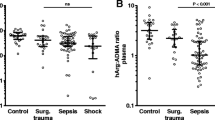Abstract
To clarify how the kinetics of nitric oxide (NO) and active oxygen species are correlated with the occurrence of organ dysfunction in sepsis, the levels of monocyte-associated NO2, NO3, and active oxygen species were examined in severely septic patients with multiple organ dysfunction syndrome (group M; n=5), and the results compared with those of postoperative patients who had undergone gastrointestinal surgery (group S; n=5) and healthy volunteers (group C; n=10). The production of NO2 and NO3 by monocytes was significantly higher in group M than in the other two groups, while the production of active oxygen species by monocytes was significantly higher in groups M and S, than in group C. A significant correlation between the production of NO2 and that of active oxygen species by monocytes was noted only in group M. These findings indicate that the simultaneous activation of NO and active oxygen species production by monocytes is a prerequisite for the onset of multiple organ dysfunction in severe sepsis.
Similar content being viewed by others
References
Moncada S (1992) The 1991 Ulf von Euler Lecture, The Larginine nitric oxide pathway. Acta Physiol Scand 145:201–227
Kolb H, Kolb BV (1992) Nitric oxide: a pathogenetic factor in autoimmunity. Immunol Today 13:157–159
Members of the ACCP/SCCM Consensus Conference Committee (1992) Definitions for sepsis and organ failure and guidelines for the use of innovative therapies in sepsis. Crit Care Med 20:846–874
Tucker SBR, Pierre RV, Jordon RE (1977) Rapid identification of monocytes in a mixed mononuclear cell preparation. J Immunol Methods 14:267–269
Munoz C, Carlet J, Fitting C, Misset B, Bleriot JP, Gavaillon JM (1991) Dysregulation of in vitro cytokine production by monocytes during sepsis. Cytokines and Sepsis 88:1747–1754
Green LC, Wagner DA, Glogowski J, Skipper PL, Wishnok JS, Tannenbaum SR (1982) Analysis of nitrate, nitrite and 15N nitrate in biological fluids. Analytic Biochem 126:131–138
Ochoa JB, Udekwu AO, Billar TR, Curran RD, Cerra FB, Simmons RL, Peitzman AB (1991) Nitric oxide levels in patients after trauma and during sepsis. Ann Surg 214:620–626
Zeller JM, Rothberg L, Landay AL (1989) Evaluation of human monocyte oxidative metabolism utilizing a flow cytometric assay. Clin Exp Immunol 78:91–96
Bass DA, Parse JW, Dechatelet LR (1983) Flow cytometric studies of oxidative product fomation by neutrophils. J Immunol 130:1910–1914
Beckman JS (1991) The double-edged role of nitric oxide in brain function and superoxide-mediated injury. J Devel Physiol 15:53–59
Author information
Authors and Affiliations
Rights and permissions
About this article
Cite this article
Tanjoh, K., Shima, A., Aida, M. et al. Nitric oxide and active oxygen species in severe sepsis and surgically stressed patients. Surg Today 25, 774–777 (1995). https://doi.org/10.1007/BF00311451
Received:
Accepted:
Issue Date:
DOI: https://doi.org/10.1007/BF00311451




